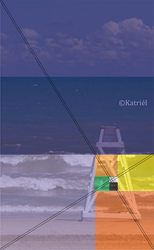|
You may wonder why certain photographs appeal to you or to a large number of people. Research may lead you to discover that these photographs share certain design layouts that are referred to as composition rules. These rules have been used not only by photographers, but by painters and architects as far back as the ancient Greeks. During the Middle Ages artists made great use of these rules. Leonardo Da Vinci's Last Supper is one of many famous examples of the application of the rule called the Golden Mean. The Golden Mean (which will be discussed later in this article), like the design rules called the Golden Spiral and the Golden Triangle are based on a common ratio found in nature. The Golden Ratio (or phi) is 1 to 1.618. A popular example of this ratio is an acorn's spirals. The Golden Spiral and Golden Triangle are paths and subdivisions of a Golden Rectangle. A rectangle is said to be 'golden" if you are able to cut out a square that has a side length which in relation to the longer rectangle is 1 to 1.618, and you can infinitely repeat this proportion by removing a square from each resulting smaller rectangle. The Golden Rectangle drawn below left is comprised of seven golden rectangles. Only space and time prevented my drawing more. The middle image displays the golden spiral, and the third the golden triangle. For a triangle to be considered golden the length of its sides must display the following relationship 1 + phi = phi squared. Otherwise it's called a harmonious triangle. So how do you apply the Golden Rectangle aka Golden Section, Golden Spiral, and Golden Triangle when shooting? Well, the first thing to do is avoid deciding on a rule first then shooting. Elements in a scene may not lend themselves to certain rules. Let what you see through your viewfinder guide you and keep in mind your main subject. Certain subjects naturally lend themselves to the use of a particular rule. For instance, flowers in a field ... the spiral rule maybe? Pick a particular flower that stands out from the rest and try to place it toward a corner of what will be the photograph. Many flowers or bouquets are already spiral in shape. If you don't like shooting flowers another option might be pets. I've seen photographs of kittiens and dogs that have come out well by framing the animal's head using the spiral rule. Train tracks scream Golden Triangle. The triangle is a popular shape in photography in general. Start looking at your environment in terms of shapes. That may help you decide which composition rule to use. Another good one for triangles are trees. The following images shows photographs with the golden spiral and golden triangle superimposed. The above photographs align fairly well with the Golden Spiral and the Golden Triangle. Of the two figuring out where to place your subject using the Golden Triangle maybe a little more difficult. When you're out in the field it maybe easier to divide a scene into harmonious triangles. To construct a harmonious triangle determine which corner will have the focus of attention, bisect your scene by drawing one line in your mind from that corner to its opposite, then draw a line from an adjacent corner to a third of the edge closest to the focus of attention. The picture below makes use of the harmonious triangle. The line from bottom right to top left bisects the image. The line drawn to create the harmonious triangle begins from lower left and moves to the opposite side and intersects the right edge of the image a third of the way. Speaking of thirds it's time to discuss the Rule of Thirds and the Golden Mean. The Rule of Thirds is a simplified version of the Golden Mean. To apply the Rule of Thirds, a photographer only needs to divide in his or her mind the scene s/he wishes to photograph in thirds horizontally and vertically with imaginary lines. The main subject is placed at the intersection of those lines Many digital cameras provide grid lines as an aide that mimic the Rule of Thirds. What's nice about the Rule of Thirds is it allows the photograph to show enough of a subject's background to offer context for your subject which can result in a more meaningful photograph. For the Golden Mean the horizontal lines must be 5/8 from the top, 5/8 from the bottom. The vertical lines must be 3/8 from the left edge and 3/8 from the right edge. These measurements come from the ancient Greeks. The first two illustrations below represent the Rule of Thirds and Golden Mean, respectively. The next row shows the illustration of the Golden Mean superimposed on an image of a bridge. The bridge is a perfect example of letting the subject guide your composition. My goal was to show the balance between the sky, the bridge, and the water. In this instance centering the bridge worked using the Golden Mean. Note that the edges of the bridge are near the intersections of the lines both above the water and in the reflection on the water's surface. Though it's always better to create a well-composed photograph at the time of image capture conditions in the field may not allow for that at that moment. Sometimes you will need to use software to recompose the image and obtain a more aesthetically pleasing result. Before continuing you should know that a couple of the photographs used in this article were edited in Photoshop but the changes had to do with converting to black and white for the rooftop images, creating a digital image of the bridge with a little bit of cropping for this article. The model's image was cropped for compositional reasons without intentionally applying the golden spiral. And that's one of the things you may come to notice about your photographs: when you stop and search for a good composition your images may wind up becoming an unintentional example of a composition rule. The next two images of a lifeguard chair were shot as you see below and if memory serves me right I think all I did in Photoshop was straighten the offcenter one a little. The third image shows how well the second photograph sits within the Rule of Thirds. For the purposes of this article I wanted to see how the chair image might change if I cropped specifically using the golden rectangle composition rule. The image below left shows the lifeguard chair with the golden rectangle layered over it as a guide for cropping. The next image is the resulting photograph. Do you prefer the cropped image below or the one composed using the Rule of Thirds? All content including photographs, images, and illustrations are copyrighted by Katriel. All rights reserved.
3 Comments
Denyse Le Blanc
1/20/2014 04:20:36 pm
I would like to paint a vertical spiral (ruled by geometry) increasing toward the bottom on a 30 x 80 cm surface. Thank you in advance for any ideas
Reply
10/19/2019 02:03:50 am
Mobile Van Advertising or Tata Ace Van Branding Service are used in promotional activities such as launching program, Inauguration of companies, advertisement of corporate companies.
Reply
Leave a Reply. |
Archives
March 2011
Categories
All
|














